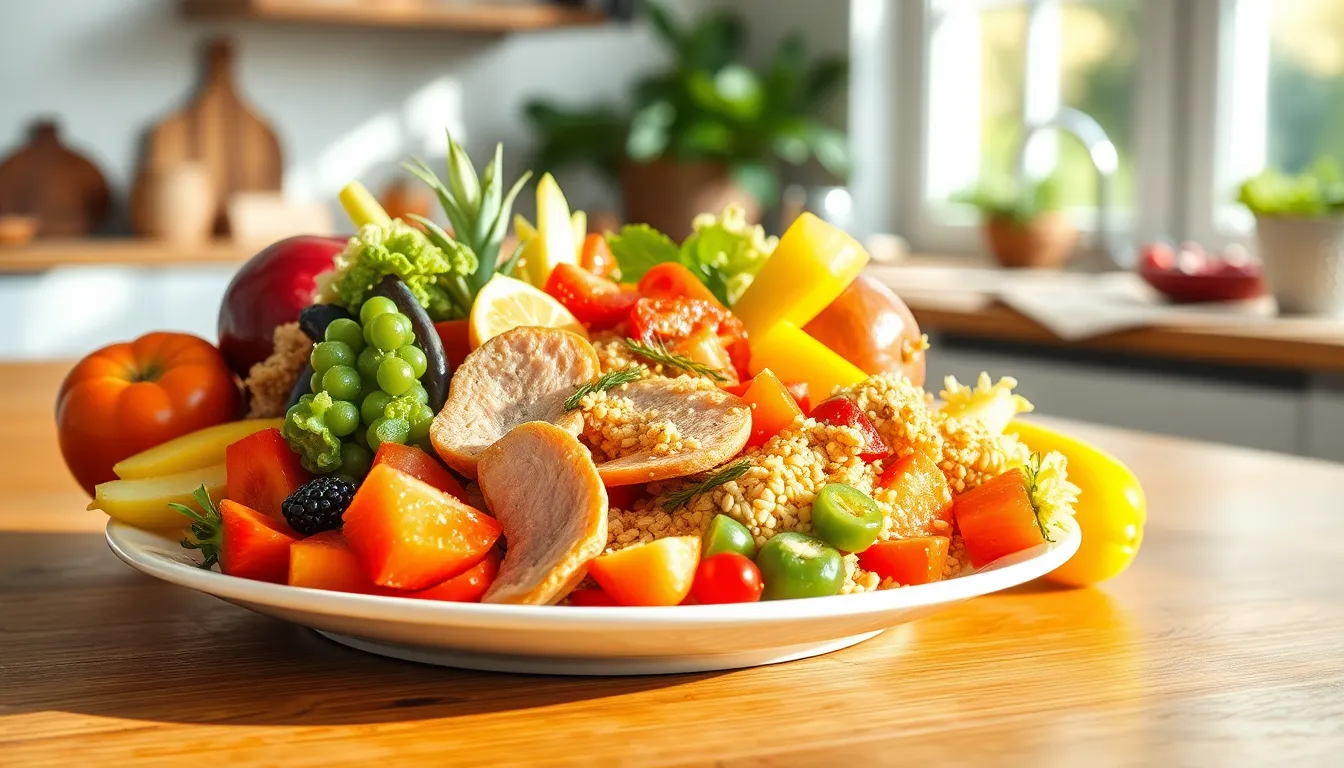In a world where kale reigns supreme and quinoa has become the new black, clean eating isn’t just a trend—it’s a lifestyle. But let’s be honest: the idea of munching on rabbit food might not sound thrilling. Fear not! Clean eating can be delicious, satisfying, and yes, even fun. With the right recipes, you can transform your meals from bland to grand, making your taste buds dance like nobody’s watching.
Table of Contents
ToggleOverview of Clean Eating Recipes
Clean eating recipes focus on whole, unprocessed foods. These recipes emphasize ingredients like fruits, vegetables, whole grains, lean proteins, and healthy fats. By using fresh ingredients, meals become nourishing and appealing.
Meal prep plays a significant role in clean eating. Planning meals in advance simplifies the cooking process and reduces reliance on unhealthy options. Popular clean eating recipes include zesty quinoa salads, savory grilled chicken with veggies, and refreshing smoothie bowls.
Using spices and herbs enhances flavor without the need for added sugars or unhealthy fats. For instance, garlic, turmeric, and basil contribute rich flavors and health benefits. Diversifying meals with unique combinations keeps the dining experience enjoyable.
Dinner options can incorporate clean eating principles. Vegetable stir-fries with brown rice or baked salmon with asparagus offer delicious, nutrient-dense choices. Preparing meals at home allows for greater control over ingredients, ensuring that each dish aligns with clean eating values.
Snacks can also fit within clean eating guidelines. Nut butter with apple slices or raw veggies with hummus serve as satisfying, health-conscious options. Incorporating these recipes into daily routines promotes a balanced approach to nutrition.
Maintaining variety is essential in clean eating. Exploring different cuisines can introduce new flavors and ingredients. Mediterranean tabbouleh, Asian lettuce wraps, and Indian lentil stews broaden the palate while adhering to clean eating principles.
Benefits of Clean Eating


Clean eating offers numerous advantages that contribute to overall well-being. Adopting this dietary approach leads to healthier food choices and a more mindful relationship with meals.
Improved Nutrition
Choosing whole, unprocessed foods enhances nutritional value. Fresh fruits and vegetables provide essential vitamins and minerals crucial for bodily functions. Whole grains supply fiber and energy, improving digestive health. Lean proteins support muscle growth and repair, aiding recovery after exercise. Healthy fats, such as those from avocados and nuts, promote heart health. By prioritizing these nutrient-dense ingredients, individuals experience balanced meals that sustain energy and support overall health.
Enhanced Energy Levels
Clean eating significantly boosts energy levels. Nutrient-rich foods provide steady energy throughout the day, unlike processed options that often lead to crashes. Whole foods stabilize blood sugar levels, resulting in fewer energy dips. Additionally, a clean eating lifestyle reduces inflammation, allowing the body to function optimally. By consuming a variety of wholesome foods, individuals maintain alertness and productivity. This dietary pattern empowers them to engage in daily activities with vitality and enthusiasm.
Popular Ingredients in Clean Eating
Clean eating relies on specific ingredients that elevate meals while promoting health. Whole foods should form the basis of every dish, enriching nutrition.
Whole Grains
Whole grains add fiber and essential nutrients to meals. Options such as brown rice, quinoa, and oats provide energy and help with digestion. Including whole grains supports heart health and stabilizes blood sugar levels. Quinoa packs protein along with its fiber content. Additionally, these grains can be easily incorporated into salads, bowls, or as side dishes.
Fresh Fruits and Vegetables
Fresh fruits and vegetables are cornerstones of clean eating. Leafy greens like kale and spinach offer vitamins and minerals crucial for overall health. Colorful options like berries, peppers, and tomatoes bring antioxidants that protect against disease. Consuming a variety of produce ensures a wide range of nutrients. Incorporating seasonal fruits makes meals fresher and tastier. Snack ideas include carrot sticks or apple slices, perfect for quick energy boosts.
Easy Clean Eating Recipes
Clean eating recipes are accessible and straightforward, featuring ingredients that nourish the body and delight the taste buds.
Breakfast Ideas
Make overnight oats a staple by combining rolled oats, almond milk, and fresh fruits. Prepare smoothies using spinach, bananas, and Greek yogurt for a nutrient-packed start. Sauté vegetables with eggs for a delicious scramble that adds fiber and protein to mornings.
Lunch Options
Create zesty quinoa salads with black beans, cherry tomatoes, and cilantro. Assemble lettuce wraps filled with grilled chicken, avocado, and salsa for a satisfying meal. Serve whole grain wraps stuffed with hummus, cucumbers, and bell peppers, ensuring a balance of flavors and nutrients.
Dinner Dishes
Opt for baked salmon marinated in lemon and dill, served alongside roasted asparagus. Enjoy a vegetable stir-fry featuring broccoli, bell peppers, and tofu, cooked in a splash of low-sodium soy sauce. Cook lentil soup with carrots, celery, and spices, providing warmth and nourishment for evenings.
Snacks and Treats
Pair apple slices with almond butter for a crunchy, satisfying snack. Enjoy homemade energy balls made with oats, nut butter, and honey for a quick treat. Munch on raw veggies like carrots and bell peppers, served with homemade hummus for a wholesome option.
Tips for Maintaining a Clean Eating Lifestyle
Planning meals ahead minimizes the chances of unhealthy snacking or last-minute unhealthy choices. Meal prep can involve cooking in bulk, portioning out meals, or simply prepping ingredients for the week.
Shopping with a list helps ensure the selection of clean ingredients. Including fruits, vegetables, whole grains, and lean proteins on the list promotes a balanced approach.
Incorporating seasonal foods enhances freshness and flavor while supporting local agriculture. Choosing items in season can lead to discovering new recipes and flavors.
Experimenting with herbs and spices boosts the flavor without extra calories or sugars. It transforms plain dishes into savory meals, expanding the culinary experience.
Staying hydrated is vital for overall health, as water aids in digestion and nutrient absorption. Flavoring water with slices of fruits or herbs may encourage increased consumption.
Listening to hunger cues prevents overeating and supports mindful eating practices. Focusing on portion sizes allows for greater enjoyment of meals while aligning with clean eating principles.
Finding a community provides support and encouragement, making the clean eating journey more enjoyable. Online groups or local clubs offer inspiration through shared recipes and experiences.
Creating a positive mindset around food fosters a healthy relationship with eating. Embracing clean eating can lead to long-lasting habits and increased energy levels, supporting overall well-being.
Prioritizing enjoyment in meals leads to sustainable clean eating practices. Sharing clean recipes with family or friends can also make the experience more fulfilling.
Embracing clean eating is about more than just choosing healthy foods; it’s a journey toward a vibrant lifestyle. With a focus on whole ingredients and flavorful recipes, individuals can enjoy meals that nourish both body and soul. By incorporating variety and creativity into daily cooking, the process becomes exciting rather than mundane.
Meal prep and mindful eating play vital roles in maintaining this lifestyle, making it easier to stick to clean eating principles. As individuals explore new flavors and connect with supportive communities, they’ll find that clean eating can lead to improved health and happiness. Ultimately, prioritizing enjoyment and balance in meals fosters sustainable habits that enhance overall well-being.



